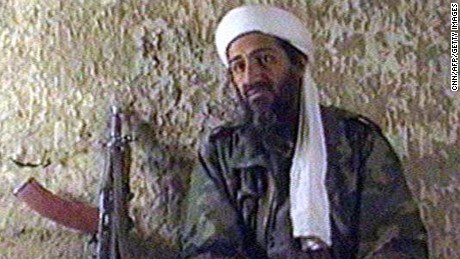Secrets of the bin Laden treasure-trove
By Peter Bergen, CNN National Security Analyst
Updated 8:19 PM ET, Wed May 20, 2015
Story highlights
- U.S. releases unprecedented number of Osama bin Laden documents from 2011 raid
- Documents show bin Laden's correspondence with family and al Qaeda associates
- Material paints complex portrait of the world's most wanted man in years before his death
Peter Bergen is CNN's national security analyst, a vice president at New America and a professor of practice at Arizona State University. He is the author of "Manhunt: The Ten-Year Search for bin Laden -- From 9/11 to Abbottabad."
(CNN)In his final years hiding in a compound in Pakistan, Osama bin Laden was a man who at once showed great love and interest in his own family while he coldly drew up quixotic plans for mass casualty attacks on Americans, according to documents seized by Navy SEALs the night he was killed.
On Wednesday morning, the U.S. Office of the Director of National Intelligence
released an unprecedented number of documents from what U.S. officials have described as the treasure-trove picked up by the SEALs at bin Laden's compound in Abbottabad, Pakistan, on May 2, 2011.

Peter Bergen
Totaling 103 documents, they include the largest repository of correspondence ever released between members of bin Laden's immediate family and significant communications between bin Laden and other leaders of al Qaeda as well as al Qaeda's communications with terrorist groups around the Muslim world.
Also released was a list of bin Laden's massive digital collection of English-language books, think tank reports and U.S. government documents, numbering 266 in total.
To the end bin Laden remained obsessed with attacking Americans. In an undated letter he told jihadist militants in North Africa that they should stop "insisting on the formation of an Islamic state" and instead attack U.S. embassies in Sierra Leone and Togo and American oil companies. Bin Laden offered similar advice to the al Qaeda affiliate in Yemen, telling it to avoid targeting Yemeni police and military targets and instead prioritize attacks on American targets.
Much of bin Laden's advice either didn't make it to these groups or was simply ignored because al Qaeda affiliates in Yemen and North Africa continued to attack local targets.
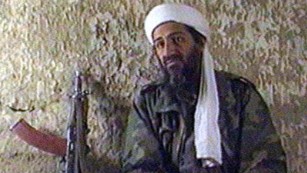
Author on bin Laden's shelf: We interfere in Muslim world 02:52
PLAY VIDEO
ISIS, of course, didn't exist at the time bin Laden was writing. The group, which now controls a large swath of territory in the Middle East, grew out of al Qaeda in Iraq and has charted a different path, seeking to create an Islamic state and not prioritizing attacks on the United States and its citizens.
Taken together, these documents and reading materials paint a complex, nuanced portrait of the world's most wanted man in the years before he was killed in the raid on his compound.
In the letters that bin Laden exchanged with his many sons and daughters, he emerges as a much-loved and admired father who doted on his children. And in a letter he sent to one of his wives, he even comes off as a lovelorn swain.
That's in sharp contrast to the letters bin Laden sent to al Qaeda leaders that demanded mass casualty attacks against American targets and insisted that al Qaeda affiliates in the Middle East stop wasting their time on attacks against local government targets. "The focus should be on killing and fighting the American people," bin Laden emphasized.
What bin Laden was reading
Bin Laden's digital library is that of an
avid reader whose tastes ran from "Obama's Wars," Bob Woodward's account of how the Obama administration surged U.S. troops in Afghanistan in 2009 and 2010, to Noam Chomsky as well as someone who had a pronounced interest in how Western think tanks and academic institutions were analyzing al Qaeda.
Bin Laden was a meticulous editor, and some of the memos he wrote were revised as many as 50 times. Of the thousands of versions of documents recovered from computers and digital media that the SEALs retrieved at bin Laden's compound, the final tally numbers several hundred documents.
The new documents show how bin Laden reacted to the events of the Arab Spring, which was roiling the Middle East in the months before his death. While bin Laden had nothing to say publicly about the momentous events in the Middle East, privately he wrote lengthy memos analyzing what was happening, pointing to the "new factor" of "the information technology revolution" that had helped spur the revolutions and characterizing them as "the most important events" in the Muslim world "in centuries."
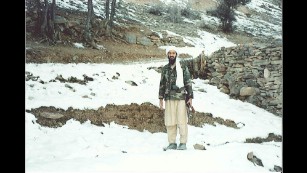
Osama bin Laden's Afghan hideout 31 photos
EXPAND GALLERY
Some of the documents paint an organization that understood it was under significant pressure from U.S. counterterrorism operations. One undated document explained that CIA drone attacks "led to the killing of many jihadi cadres, leaders and others," and noted, "(T)his is something that is concerning us and exhausting us." Several documents mention the need to be careful with operational security and to encrypt communications and also the necessity of making trips around the Afghan-Pakistan border regions only on "cloudy days" when American drones were less effective.
Al Qaeda members knew they were short on cash, with one writing to bin Laden, "Also, there is the financial problem."
Some of the documents have nothing to do with terrorism. One lengthy memo from bin Laden worried about the baleful effects of climate change on the Muslim world and advocated not depleting precious groundwater stocks. Sounding more like a World Bank official than the leader of a major terrorist organization, bin Laden fretted about "food security." He also gave elaborate instructions to an aide about the most efficacious manner to store wheat.
Family concerns
Many of the documents concern bin Laden's sprawling family, which included his four wives and 20 children. Bin Laden took a minute interest in the marriage plans of his son Khalid to the daughter of a "martyred" al Qaeda commander, and he exchanged a number of letters with the mother of the bride-to-be. Bin Laden excitedly described the impending nuptials, "which our hearts have been looking forward to."
Bin Laden corresponded at length with his son Hamza and also with Hamza's mother, Khairiah, who had spent around a decade in Iran under a form of house arrest following the Taliban's fall in neighboring Afghanistan during the winter of 2001.
Hamza wrote a heartfelt letter to bin Laden in 2009 in which he recalled how he hadn't seen his father since he was 13, eight years earlier: "My heart is sad from the long separation, yearning to meet with you. ... My eyes still remember the last time I saw you when you were under the olive tree and you gave each one of us Muslim prayer beads."
In 2010 the Iranians started releasing members of the bin Laden family who had been living in Iran. Bin Laden spent many hours writing letters to them and to his associates in al Qaeda about how best he could reunite with them.
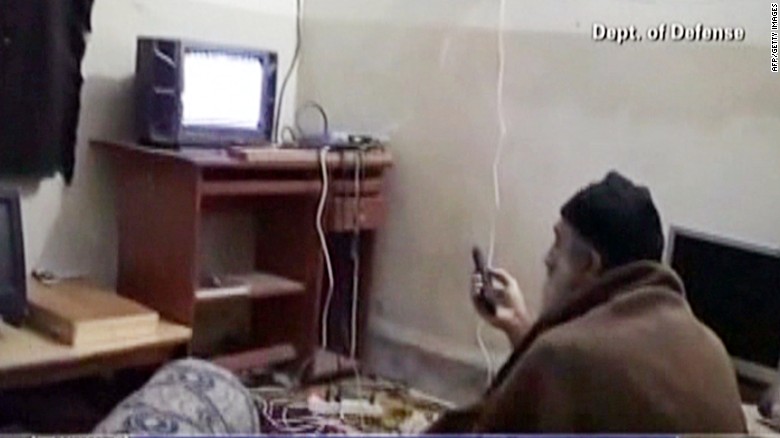
Bin Laden watches TV at his Abbottabad, Pakistan, compound in a frame grab from an undated video from the Pentagon.
In a letter to his wife Khairiah, he wrote tenderly, "(H)ow long have I waited for your departure from Iran."
Bin Laden was paranoid that the Iranians -- who he said were "not to be trusted" -- might insert electronic tracking devices into the belongings or even the bodies of his family as they departed Iran. He told Khairiah that if she had recently visited an "official dentist" in Iran for a filling that she would need to have the filling taken out before meeting with him as he worried a tracking device might have been inserted inside.
U.S. intelligence officials have a theory that bin Laden might have been grooming Hamza eventually to succeed him at the helm of al Qaeda because the son's relative youth would energize al Qaeda's base. But Hamza never made it to his father's hiding place in Abbottabad. When the SEALs raided bin Laden's compound, they assumed Hamza would likely be one of the adult males living there, but he wasn't.
U.S. intelligence officials say they don't know where Hamza, now in his late 20s, is today.
'In case you became a martyr'
As is typical for any bureaucratic organization there was considerable discussion in the documents about which al Qaeda personnel might be suitable for promotion and also documentation of cash flows moving in and out of the organization, in amounts in the tens of thousands of euros.
There is even an al Qaeda application form that included standard questions such as what "hobbies" the applicant might have, but also less standard ones such as, "Who should we contact in case you became a martyr?"
Under pressure from bin Laden, leaders of al Qaeda in Yemen noodled with the idea that they might negotiate some kind of truce with the Yemeni government so the group could focus exclusively on attacking American targets. It's not clear if anything came of this.
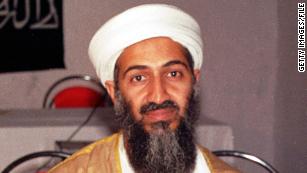
Osama bin Laden's compound 9 photos
EXPAND GALLERY
Similarly, al Qaeda members reached out to leaders of the Pakistani Taliban who maintain contacts with Pakistan's military intelligence service, ISI, to see if they could negotiate a similar truce with the Pakistani government. The deal would be that the Pakistanis would leave al Qaeda alone and vice versa and then al Qaeda would be able to focus on attacking American targets. However, the al Qaeda leader who was leading this effort told bin Laden, "As you know, this is just talk!" and nothing came of these discussions.
There is no evidence in the newly released documents that the Pakistanis had any idea bin Laden was living in Pakistan or indeed he was even alive.
The new documents also do nothing to substantiate investigative journalist's
Seymour Hersh's recent well-publicized claims that the raid that killed bin Laden was not a firefight in which the SEALs went into a dangerous and unknown situation, but a setup in which Pakistan's military had been holding bin Laden prisoner in Abbottabad for five years and simply made him available to the SEALs when they flew in helicopters to the compound on the night of the raid.
White House rejects Hersh's 'baseless assertions'
On the first anniversary of
bin Laden's death in May 2012, the Obama administration released a first tranche of
17 documents from the treasure-trove. Those documents also underlined how much al Qaeda feared the CIA drone campaign as well as bin Laden's obsessive interest in attacking the United States.

Bergen: Hersh's account of bin Laden raid is nonsense 05:25
PLAY VIDEO
Hersh seems to believe that any documents released by the Obama administration that were discovered during the bin Laden raid have been faked by the CIA.
Readers can judge for themselves by examining the English-language translations of the new documents and also the original Arabic documents here.
According to U.S. intelligence officials, in October seven U.S. intelligence agencies began the process of clearing for public release the documents that came out Wednesday.
Bergen: Was there a cover-up in bin Laden killing?
Digital library
Among the most interesting windows in to the mind of al Qaeda's leader are the contents of his massive digital library, which was painstakingly assembled. Because of security concerns, bin Laden's compound had no connection to the Internet so any books or reports that bin Laden had an interest in were assembled painstakingly by making PDFs of each page. They were then put on to a thumb drive and delivered to bin Laden by one of his two bodyguards, according to U.S. intelligence officials.
Strangely, one of the books in bin Laden's digital library was a suicide prevention manual. Senior U.S. intelligence officials do not believe that bin Laden was suicidal.
Bin Laden was interested in books with a conspiratorial bent, and he had tomes about the Illuminati and the Freemasons and even, somewhat ironically, a book that asserted 9/11 was an "inside job."
Bin Laden also collected reports by leading American counterterrorism exports such as Bruce Hoffman and Paul Pillar as well as papers about al Qaeda by West Point's Combating Terrorism Center, RAND Corp. and the Congressional Research Service. (He even possessed congressional testimony by this author titled, "Reassessing the Evolving al Qaeda threat to the Homeland.")
Bin Laden collected indictments from American terrorism cases that he found of interest, such as that of
David Coleman Headley from Chicago, who al Qaeda had tasked to plan an attack against a Danish newspaper that had published cartoons of the Prophet Mohammed.
During the almost six years bin Laden lived in the Abbottabad compound, he had a great deal of time on his hands, which was partly consumed by reading the many holdings in his digital library and also composing the memos and letters that are now becoming public.
Bin Laden was deeply aware that as the 10th anniversary of 9/11 approached his central goal of attacking the United States again had failed. Many of the documents reference his plans for some kind of major public statement to mark the anniversary. Bin Laden was killed three months before he could deliver this statement.
A gripping glimpse into bin Laden's decline and fall
